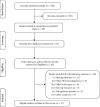Fascia Iliaca Compartment Block for Perioperative Pain Management of Geriatric Patients with Hip Fractures: A Systematic Review of Randomized Controlled Trials
- PMID: 33294087
- PMCID: PMC7714603
- DOI: 10.1155/2020/8503963
Fascia Iliaca Compartment Block for Perioperative Pain Management of Geriatric Patients with Hip Fractures: A Systematic Review of Randomized Controlled Trials
Abstract
Background: With continuous increase of the aging population, the number of geriatric patients with fragility hip fractures is rising sharply, and timely surgery remains the mainstay of treatment. However, adequate and effective pain control is the precondition of satisfactory efficacy. This systematic review aimed to summarize the use of fascia iliaca compartment block (FICB) as an analgesic strategy for perioperative pain management in geriatric patients with hip fractures.
Methods: PubMed and Embase databases were searched for English published randomized controlled trials (RCTs) reporting application of FICB for pain control of the older adults with hip fractures between January 1st, 2000, and May 31st, 2020. The modified Jadad scale was used to evaluate quality of the RCTs included. Primary outcomes of the eligible RCTs were presented and discussed.
Results: A total of 27 RCTs with 2478 cases were included finally. The present outcomes suggested, after admission or in the emergency department (ED), FICB can provide patients with equal or even better pain relief compared with the conventional analgesia methods, which can also reduce additional analgesic consumptions. While, before positioning for spinal anesthesia (SA), FICB is able to offer superior pain control, facilitating SA performance, after surgery FICB can effectively alleviate pain with decreased use of additional analgesics, promoting earlier mobilization and preventing complications.
Conclusions: FICB is a safe, reliable, and easy-to-conduct technique, which is able to provide adequate pain relief during perioperative management of geriatric patients with hip fractures.
Copyright © 2020 Hao-yang Wan et al.
Conflict of interest statement
The authors declare that there are no conflicts of interest regarding the publication of this article.
Figures
Similar articles
-
Fascia iliaca compartment block as a preoperative analgesic in elderly patients with hip fractures - effects on cognition.BMC Geriatr. 2019 Sep 11;19(1):252. doi: 10.1186/s12877-019-1266-0. BMC Geriatr. 2019. PMID: 31510918 Free PMC article. Clinical Trial.
-
Fascia-iliaca compartment block vs intra-articular hip injection for preoperative pain management in intracapsular hip fractures: A blind, randomized, controlled trial.Injury. 2018 Dec;49(12):2203-2208. doi: 10.1016/j.injury.2018.09.042. Epub 2018 Sep 26. Injury. 2018. PMID: 30274756 Clinical Trial.
-
Comparison of USG-guided or landmark approach fascia iliaca compartment block for positioning in elderly hip fracture patients with spinal anesthesia: a randomized controlled observational study.Turk J Med Sci. 2021 Dec 13;51(6):2908-2914. doi: 10.3906/sag-2011-254. Turk J Med Sci. 2021. PMID: 34217171 Free PMC article. Clinical Trial.
-
The Application of Fascia Iliaca Compartment Block for Acute Pain Control of Hip Fracture and Surgery.Curr Pain Headache Rep. 2021 Mar 11;25(4):22. doi: 10.1007/s11916-021-00940-9. Curr Pain Headache Rep. 2021. PMID: 33694008 Review.
-
The efficacy of fascia iliaca compartment block for pain control after total hip arthroplasty: a meta-analysis.J Orthop Surg Res. 2019 Jan 25;14(1):33. doi: 10.1186/s13018-018-1053-1. J Orthop Surg Res. 2019. PMID: 30683117 Free PMC article. Review.
Cited by
-
Clinical Effects and Safety of Auricular Acupressure as an Adjunct Therapy on Postoperative Pain among Patients with Hip Fracture: A Meta-Analysis.Pain Res Manag. 2023 Apr 24;2023:5077772. doi: 10.1155/2023/5077772. eCollection 2023. Pain Res Manag. 2023. PMID: 37143907 Free PMC article.
-
Timing of suprainguinal fascia iliaca block in hip hemiarthroplasty: impact on QoR-15 scores- a prospective randomized study.BMC Anesthesiol. 2025 Apr 12;25(1):179. doi: 10.1186/s12871-025-03060-8. BMC Anesthesiol. 2025. PMID: 40221676 Free PMC article. Clinical Trial.
-
Peripheral Nerve Block and Peri-operative Neurocognitive Disorders in Older Patients With Hip Fractures: A Systematic Review With Meta-analysis.Geriatr Orthop Surg Rehabil. 2023 Jul 4;14:21514593231186722. doi: 10.1177/21514593231186722. eCollection 2023. Geriatr Orthop Surg Rehabil. 2023. PMID: 37435444 Free PMC article. Review.
-
Emergency department pain management in special populations.Turk J Emerg Med. 2025 Jul 1;25(3):159-177. doi: 10.4103/tjem.tjem_141_25. eCollection 2025 Jul-Sep. Turk J Emerg Med. 2025. PMID: 40746577 Free PMC article. Review.
-
Equivalent outcomes of ultra-congruent and standard cruciate-retaining inserts in total knee arthroplasty.Knee Surg Sports Traumatol Arthrosc. 2022 Sep;30(9):3076-3091. doi: 10.1007/s00167-021-06833-z. Epub 2022 Jan 11. Knee Surg Sports Traumatol Arthrosc. 2022. PMID: 35013748
References
-
- Cummings S. R., Rubin S. M., Black D. The future of hip fractures in the United States. Numbers, costs, and potential effects of postmenopausal estrogen. Clinical Orthopaedics and Related Research. 1990;252:163–166. - PubMed
Publication types
MeSH terms
Substances
LinkOut - more resources
Full Text Sources
Medical


